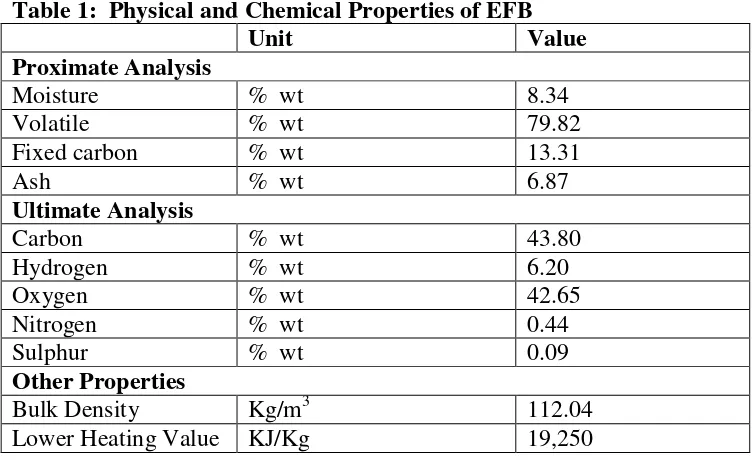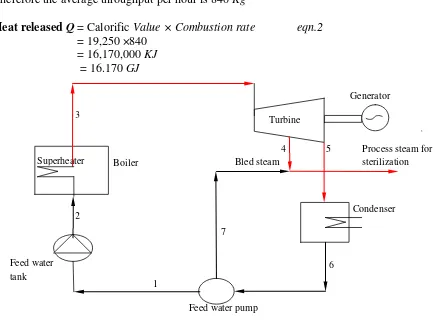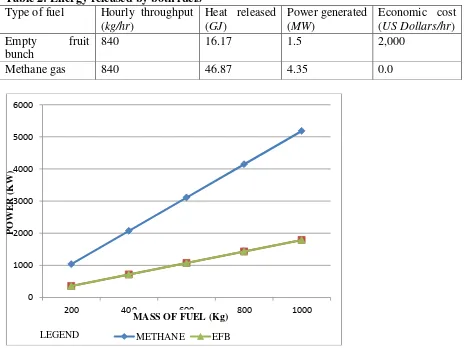UTILIZATION OF PALM EMPTY FRUIT BUNCH (PEFB) AS SOLID FUEL FOR STEAM BOILER
Y.P. Olisa
Department of Mechanical Engineering, Niger Delta University, Wilberforce Island
Bayelsa State, NIGERIA
&
K.W. Kotingo
Department of Mechanical Engineering, Niger Delta University, Wilberforce Island
Bayelsa State, NIGERIA
ABSTRACT
The reclamation of energy from the by-product of palm fresh fruit bunch (PFFB) after processing into palm oil can be seen as an alternative to fossil fuel. This study therefore examined the utilization of empty fruit bunch (EFB) as an alternative fuel for firing a steam turbine plant for the production of electricity. The power plant used for this study produces 1.5 MW of electricity by burning EFB at the rate of 840 Kg per hour, given the same rate of combustion, this value was compared to a conventional power plant fired with methane gas which produces 4.35 MW. In Nigeria the economic cost of producing this magnitude of electricity by methane gas is estimated at about two thousand dollars per hour ($2,000/hr). On the other hand it cost virtually nothing or little amount to procure EFB which is seen as a waste by small scale oil Plantation Companies, the only cost incurred probably comes from transportation of the material, thus making the use of EFB very economical as an alternative fuel for firing a boiler plant.
Keywords: Biomass, Energy, Boiler, Electricity.
INTRODUCTION
The demand for alternative energy is increasing worldwide and a lot of research activities are currently going on to find alternatives to the finite fossil energy. These alternatives are intended to address concerns about the exhaustion of fossil fuels because we cannot keep using them forever; they will eventually run out, even as the population of Earth grows.There is the need to find replacement fuels because the people on earth are rapidly using up resources that cannot be replaced, fuels like coal and oil are going to run out for future generations if something is not done. The fuels were made by species that no longer exit after millions of years of time to decay and transfer (Kate et al., 1997). It has become a common sense to conserve the existing fuel resources so that it can last for as long as possible without damaging the economic wellbeing of the society.
world's total energy supply and as much as 35% in developing countries, mostly for cooking and heating (Bui et al., 1994). Broadly speaking, it is organic material produced by the photosynthesis of light. The chemical material (organic compounds of carbons) stored can be converted for everyday human use through processes such as combustion, which releases the carbon dioxide stored in the plant material with the liberation of heat which can then be used to generate energy.Considerable research and development work is currently underway to develop smaller gasifiers that would produce electricity on a small-scale. For the moment, however, biomass is used for off-grid electricity generation, but almost exclusively on a large industrial-scale (Hussain et al., 2006). There are several types of biomass available from palm oil plantations and palm oil process: the clearing of old palm oil trees, empty fruit
bunches (EFB’s), mesocap fiber, palm kernel shells (PKS), and palm kernel cakes (PKC)
which is less widely used. Palm Biomass is one kind of Bio-Energy or Bio-Fuel, It is known as white coal, is another ideal fuel which can substitutes coal, firewood, lignite and other conventional fuel.
EFB is the main source of palm biomass that could be utilized by a power plants as this is more readily available and abundant. Many plantations use a small amount for their own internal use, but a large portion is put aside, either biodegrading into compost, or at times burnt to avoid space loss by storage. Therefore, there is a substantial amount of EFB left unused.Raw Shredded EFB can be used as solid fuel for steam boiler and many companies have started replacing their fossil fuel by using Shredded EFB for boiler combustion process; these companies experience cost saving for this change. Such an important amount of feedstock for power generation represents a very attractive potential and its utilization has to be fully developed. In the large and medium-scale mills the above-mentioned waste products can be put to economically useful purpose and could therefore be referred to as by-products rather than waste product (Owen, 2006).Presco Palm Oil Industry located in Ikpoba-Okha Edo state of Nigeria is one of the major agro-industries of the West African region. The company depends solely on the electricity generated from its power plant by using EFB as the source of fuel for the boiler combustion to produce steam and generate 1.5MW of electricity
In this study, the objective is predicated on the need to utilize EFB as a source of fuel for firing a boiler plant to produce steam and generate electricity. The energy produced by fuels and economic cost of using this fuel will be compared to the conventional gas fired boiler.
METHODOLOGY
The Physical and Chemical Properties of EFB
Each fuel has its own chemical and physical properties that need to be carefully understood in order to develop adapted design for feeding and combustion, Palm EFB is no exception, table 1 shows the physical and chemical properties of EFB.
Table 1: Physical and Chemical Properties of EFB
Unit Value
Proximate Analysis
Moisture % wt 8.34
Volatile % wt 79.82
Fixed carbon % wt 13.31
Ash % wt 6.87
Ultimate Analysis
Carbon % wt 43.80
Hydrogen % wt 6.20
Oxygen % wt 42.65
Nitrogen % wt 0.44
Sulphur % wt 0.09
Other Properties
Bulk Density Kg/m3 112.04
Lower Heating Value KJ/Kg 19,250
The Chemical Formula of EFB
If the equivalent formula for the fuel (EFB) sample = CaHbOcNdSe , on the basis of 100kg of the fuel from Table 1, the composition by masses gives:
C: 12a = 0.438; a = 0.037
H: 1b = 0.062; b = 0.062
O: 16c = 0.427; c = 0.027
N: 14d = 0.0044; d = 0.00031
S: 32e = 0.0009; e = 0.000028
Hence, the formula of the fuel sample
C0.037H0.062O0.027N0.00031S0.000028
Combustion of EFB in the Boiler
Combustion of fuels in the boiler take into account the fuel calorific values, the fuel ash content, fuel size and moisture content. A complete combustion will in theory produce only water vapour, carbon dioxide and other by-products
The combustion equation for the fuel sample thus becomes:
C0.037H0.062O0.027N0.00031S0.000028 + χO2+ χ N2
→ pCO2 + qH2O + rSO2 + sN2 Balancing the equation gives:
C: 0.037 = p; p = 0.037
H: 0.062 = 2q; q = 0.031
S: 0.000028 = r; r = 0.000028
O: 0.027 + 2 χ = 2p + q + 2r
χ = 0.039
N: 0.00031 + 2χ = 2s
0.00031 + 0.293 = 2s
S = 0.147
Hence, the balanced combustion equation thus becomes:
C0.037H0.062O0.027N0.00031S0.000028+ 0.039O2+ 0.039 N 2
→ 0.037CO2 + 0.031H2O + 0.000028SO2 + 0.147N2 + Energy
Rate of Feeding into the Furnace and the amount of Heat Liberated
Shredding process cut EFB into smaller and loose structure, which improves the volume-weight ratio, this enhances the bio-fuel characteristic. The calculated combustion rate is presented in equ.1. The schematic diagram of the power plant cycle is represented in figure1
Combustion Rate CR = Total mass of fuel burnt eqn.1
Burning Time
= 840 1 hour
= 840 Kg/hour
Therefore the average throughput per hour is 840 Kg
Heat released Q = Calorific Value × Combustion rate eqn.2
= 19,250 ×840 = 16,170,000 KJ
= 16.170 GJ
Process steam for sterilization
Condenser 4
2
1
Bled steam
5 3
Feed water pump Feed water
tank
Turbine
Generator
6 7
Boiler Superheater
LEGEND
Steam
Condensate
Power produced by the EFB
The power produced from burning 10,358 Kg of EFB is given in eqn.3 Shaft Power = m × Cv× ηcircle +η turbine +ηheat transfer +ηcombustion -eqn.3 (Rajput, 7
th
Edition) 3600
The following parameters are taking into consideration Cycle efficiency, ηcircle = 46%
Turbine efficiencyηturbine = 90%
Boiler heat transfer efficiencyηheat transfer = 85%
Combustion efficiencyηcombustion = 95%
Calorific value Cv = 19,250 kJ/kg
Mass of fuel m = 840 kg
Shaft Power = 840 × 19,250 × 0.46× 0.9×0 .85×0.95 3600
= 1501.6 kW
= 1.5 MW
Comparison with a Conventional Gas Fired Boiler using Methane Gas Combustion of methane gas
CH4 + O2→ CO2 + H2O + Energy Heat released by methane gas
Calorific value of methane = 55,792.8 kJ/kg Mass of methane = 840kg
Heat released Q = Calorific Value × Combustion rate
= 55,793 × 840 = 46866120 kW
= 46.87 GJ
Power produced using methane gas
The power produced from burning 840 Kg of methane gas is given in equ. 1 when the same parameters for EFB are taking into consideration
Cycle efficiency, ηcircle = 46%
Turbine efficiencyηturbine = 90%
Boiler heat transfer efficiencyηheat transfer = 85%
Combustion efficiencyηcombustion = 95%
Shaft Power = 840 × 55,793 × 0.46× 0.9×0 .85×0.95 3600
= 4352.1 kW
= 4.35 MW
DISCUSSION OF RESULTS
P can produce about 35.5% of what methane gas produces given the same amount of fuel. For a power plant using methane gas as fuel it cost about $2,000 US dollars per hour to operate and virtually cost nothing to use EFB as fuel in a country like Nigeria, the material is seen as a waste by the numerous small scale oil plantation mills and has to be disposed of either by landfill or open burning, thereby contributing more to the existing waste management problems.
Graph 1; comparison in power produced by Methane and EFB
CONCLUSION
In Nigeria most of the palm oil produced is by small scale palm mill industries and the by– product of the processing; EPF bunch, fibre and shell are always discarded as waste and end in landfill or indiscriminately burnt creating environmental pollution, this is a huge amount of energy being wasted away, which otherwise could have been effectively used to generate electricity and reduce the demand on fossil fuel. Due to its low chlorine content, shredded EFB fiber is a safe and sustainable bio-fuel resource to replace petroleum, gas and coal. If the contribution of biomass to the world energy economy is to grow, technological innovations will be needed, so that biomass can be converted to usable energy in ways that are more efficient, less polluting, and at least as economical as today's practices.
REFERENCES
Abdullah, N., Gerhauser, H., & Bridgwater, A.V. (2007) Bio-oil from fast pyrolysis of oil palmempty fruit bunches, Journal of Physical Science, 18, 57-74.
Bui, T., Loof, R., & Bhattacharya, S. C. (1994) Multi-stage reactor for thermal gasification of wood. Energy, 19(4), 397-404.
Bull S.R. (2001) Renewable energy today and tomorrow, Proceedings of the IEEE, 89, 1216- 1226.
Corley, R.H.V., & Tinker, P.B.H. (2008) The oil palm: World Agriculture Series. Edition 4th. John Wiley & Sons.
Hussain, A., Ani, F.N., & Darus, A.N. (2006) Thermochemical behaviour of empty fruit bunches and Oil Palm Shell Waste in a Circulating Fluidized-Bed Combustor (CFBC), Journal of Oil Palm Research, 18, 210-218.
Kate, R., Deshmukh, G., & Tandale, M. S. (1997) Energy from biomass – a perspective under Indian conditions. Proc. of the International Symposiumon Advances in Alternative and Renewable Energy.Organized by Universiti Teknologi Malaysia, Johor,Malaysia. p. 63-69.
Kritsana, S., & Suneerat P. (2011) Assessment and improvement of energy utilization in crude palm oil mill. International Conference on Chemistry and Chemical Process pp161-166
Owen A.D. (2006) Renewable energy: Externality costs as market barriers, Energy Policy, Vol.34, 632–642.


